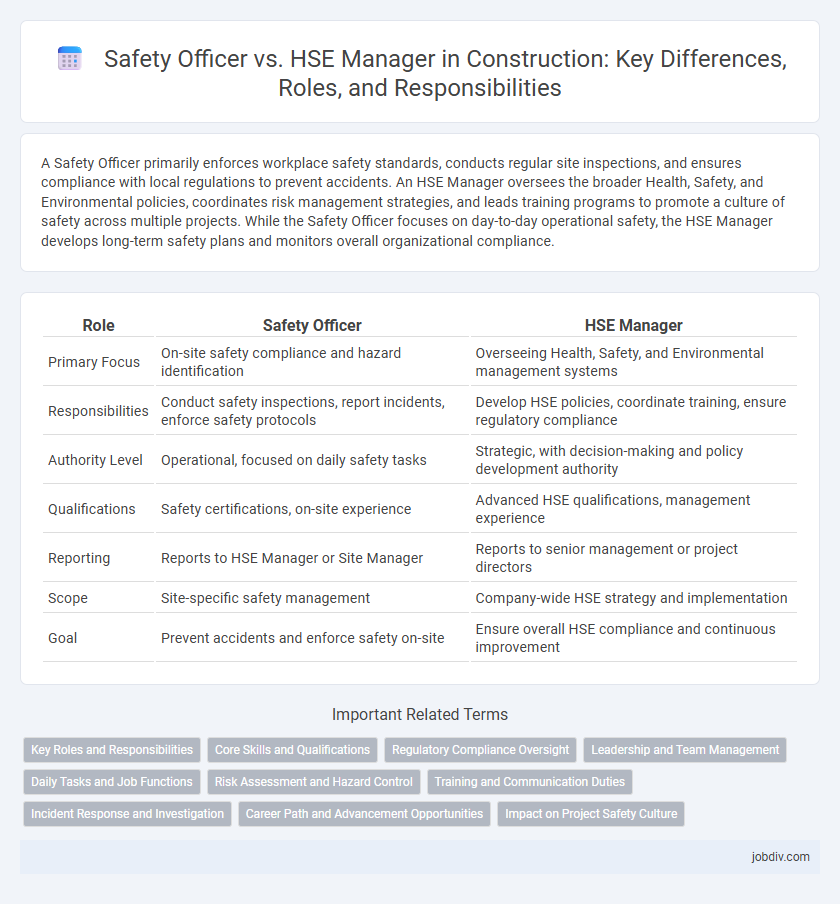A Safety Officer primarily enforces workplace safety standards, conducts regular site inspections, and ensures compliance with local regulations to prevent accidents. An HSE Manager oversees the broader Health, Safety, and Environmental policies, coordinates risk management strategies, and leads training programs to promote a culture of safety across multiple projects. While the Safety Officer focuses on day-to-day operational safety, the HSE Manager develops long-term safety plans and monitors overall organizational compliance.
Table of Comparison
| Role | Safety Officer | HSE Manager |
|---|---|---|
| Primary Focus | On-site safety compliance and hazard identification | Overseeing Health, Safety, and Environmental management systems |
| Responsibilities | Conduct safety inspections, report incidents, enforce safety protocols | Develop HSE policies, coordinate training, ensure regulatory compliance |
| Authority Level | Operational, focused on daily safety tasks | Strategic, with decision-making and policy development authority |
| Qualifications | Safety certifications, on-site experience | Advanced HSE qualifications, management experience |
| Reporting | Reports to HSE Manager or Site Manager | Reports to senior management or project directors |
| Scope | Site-specific safety management | Company-wide HSE strategy and implementation |
| Goal | Prevent accidents and enforce safety on-site | Ensure overall HSE compliance and continuous improvement |
Key Roles and Responsibilities
A Safety Officer primarily focuses on implementing on-site safety protocols, conducting regular inspections, and ensuring immediate compliance with occupational health and safety regulations to prevent accidents. An HSE Manager oversees the development and management of comprehensive health, safety, and environmental policies, coordinates risk assessments, and leads training programs to foster a culture of safety across multiple projects. Both roles collaborate to minimize workplace hazards, but the HSE Manager holds strategic responsibility, while the Safety Officer handles operational enforcement.
Core Skills and Qualifications
Safety Officers possess expertise in hazard identification, risk assessment, and regulatory compliance with certifications such as OSHA or NEBOSH, emphasizing practical site safety enforcement and incident reporting. HSE Managers require advanced qualifications including degrees in occupational health or environmental management, alongside strategic skills in policy development, safety training program design, and leadership in regulatory audits. Both roles demand strong communication and problem-solving abilities, with HSE Managers focusing more on comprehensive health, safety, and environmental program integration across projects.
Regulatory Compliance Oversight
Safety Officers ensure daily adherence to construction site safety protocols by monitoring worker compliance with OSHA regulations and reporting hazards. HSE Managers develop and implement comprehensive safety management systems aligned with federal and state regulatory standards, conducting audits and risk assessments to maintain regulatory compliance. Both roles are crucial for enforcing workplace safety, but HSE Managers oversee broader policy enforcement and continuous improvement strategies.
Leadership and Team Management
Safety Officers oversee daily site safety protocols, enforce compliance, and conduct risk assessments, directly leading frontline teams to prevent accidents. HSE Managers develop comprehensive health, safety, and environmental strategies, coordinate cross-departmental initiatives, and provide high-level leadership to align safety goals with organizational objectives. Both roles require strong team management skills, but HSE Managers focus on strategic leadership while Safety Officers emphasize operational supervision.
Daily Tasks and Job Functions
Safety Officers conduct site inspections, monitor compliance with safety regulations, and ensure the use of personal protective equipment to prevent workplace accidents. HSE Managers develop safety policies, oversee risk assessments, and coordinate training programs to promote a culture of health, safety, and environmental compliance across construction projects. While Safety Officers handle on-site operational safety, HSE Managers focus on strategic planning and regulatory adherence at a higher organizational level.
Risk Assessment and Hazard Control
Safety Officers conduct detailed risk assessments on construction sites by identifying potential hazards, evaluating the likelihood of incidents, and recommending immediate control measures to mitigate risks. HSE Managers oversee the development and implementation of comprehensive hazard control strategies, ensuring compliance with legal standards and integrating safety policies across multiple projects. Both roles are essential in maintaining workplace safety, with Safety Officers focusing on on-ground risk evaluation and HSE Managers emphasizing policy enforcement and continuous improvement.
Training and Communication Duties
Safety Officers conduct daily safety training sessions and ensure clear communication of safety protocols on construction sites to prevent accidents. HSE Managers develop comprehensive safety training programs and coordinate communication strategies across all departments to maintain regulatory compliance and promote a safety culture. Both roles require effective communication skills, but HSE Managers focus on strategic training development while Safety Officers emphasize hands-on implementation.
Incident Response and Investigation
Safety Officers directly manage on-site incident response by securing the area, providing first aid, and reporting immediate hazards to prevent further risks. HSE Managers oversee the comprehensive incident investigation process, analyzing root causes, implementing corrective actions, and ensuring compliance with regulatory standards to improve safety policies. Effective collaboration between Safety Officers and HSE Managers enhances workplace safety by combining prompt response with strategic prevention measures.
Career Path and Advancement Opportunities
Safety Officers typically begin their careers overseeing daily site safety protocols, gaining hands-on experience in hazard identification and risk mitigation. With advanced certifications and proven leadership skills, they can progress to HSE Manager roles, where they lead strategic safety initiatives and ensure compliance across multiple projects. Career advancement for HSE Managers often includes executive positions such as Safety Director or Regional Safety Manager, reflecting broader scope and increased responsibility in construction safety management.
Impact on Project Safety Culture
Safety Officers enforce on-site safety protocols, conducting regular inspections and immediate hazard mitigation, which directly reduces accident rates and fosters compliance among workers. HSE Managers develop comprehensive safety strategies and training programs, influencing the broader organizational safety culture by integrating environmental, health, and safety standards into project planning and execution. Their combined roles create a proactive safety environment, enhancing worker awareness and minimizing risks throughout the construction lifecycle.
Safety Officer vs HSE Manager Infographic

 jobdiv.com
jobdiv.com